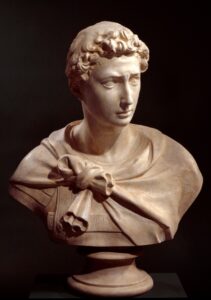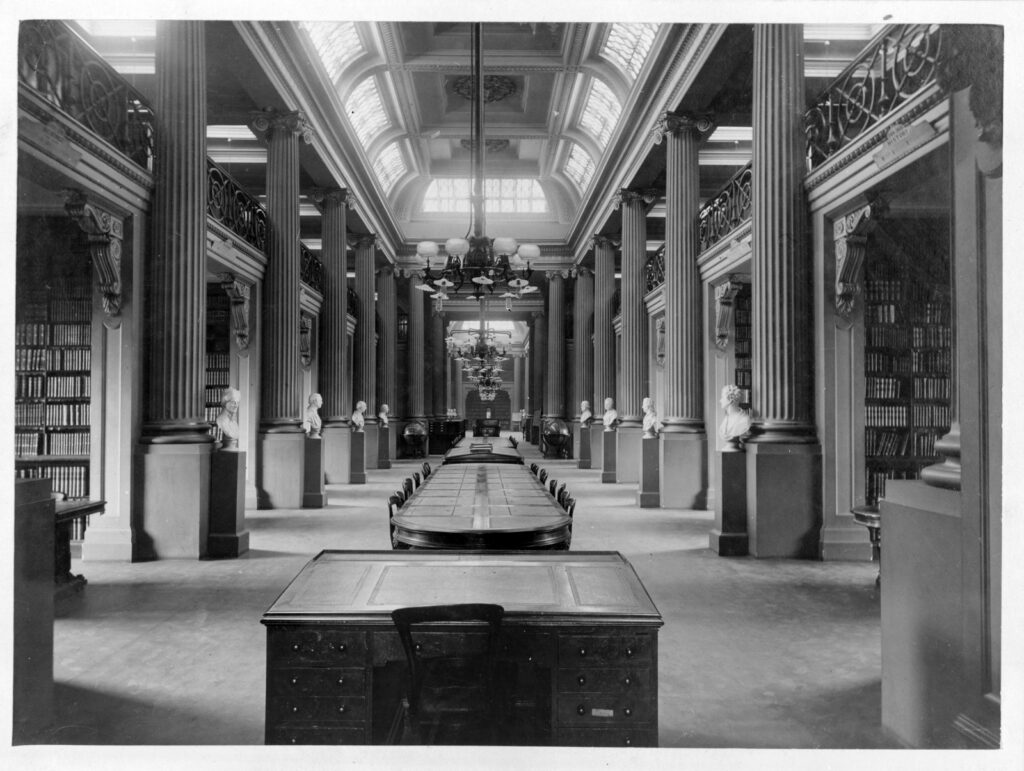
The initial group of casts ordered for Melbourne from Brucciani included “48 Busts of remarkable persons selected not for their artistic value, but for the celebrity of the persons represented”: see letter of 26 October 1860 from R.Chester Waters to Redmond Barry, quoted by Galbally, “Lost museum,” 1988, p.37. Others were purchased in the next few years. Galbally (p.37) adds that a selection was installed in Queen’s Hall, emulating similar arrangements at Trinity College, Dublin, and elsewhere, familiar to Redmond Barry and his peers: see photo above (Galbally dates this to c.1870, but the SLV catalogue suggests c.1910, noting electric wiring).
As it stood, the selection of busts of “remarkable persons” was inherently conservative (women, for example, were largely absent). A list of about 80 further desirable busts was published in AR 1870-71, p.95 (Schedule C), and some 20 of these were purchased in 1872 and later. Various other names on this list (Charlotte Bronte, Blake, Dickens, Garibaldi, Poe, and so on), would have added significant variety to the original selection.
Even so, the existing list provides some interesting exceptions to the expected roll-call of British prime ministers and other worthies. Some of the more adventurous choices included artists, scientists and engineers (including noted Europeans and Americans), and even a few radical political figures, e.g. Charles Fox (II.50), Daniel O’Connell (II.96), Richard Cobden (II.29) and John Bright (II.13).
Some noted Australians also appeared, including Robert O’Hara Burke (II.18) and George Augustus Robinson (II.108). However, busts of William Lanne, Truganini and Woureddy (II.70, 124 and 134), donated by William Lynch in 1891 as “casts of the last three survivors of the Tasmanian Race,” were seen as more appropriately housed in the MPL’s Ethnographic collection.
Also listed here are various casts after antique and more recent heads and “masks.” The order is alphabetical. Unlike Melbourne’s casts after antique and later statuary (see Casts – I.Statues, statuettes and reliefs), the original sources for most of these busts and heads cannot be identified with confidence (comparative photos are supplied only for definite or probable sources). General biographical references have been consulted for the most part; ADB refers to the Australian Dictionary of Biography (available online). For further general remarks and notes on references etc., see introductory entry on Plaster Casts.
NB only a few of these busts appear to be extant, notably four still in the SLV: II.21 (Carlyle), II.30 (Coleridge), II.43 (Dryden) and II.108 (Robinson). Research into the whereabouts of other examples is continuing.
II.1 A’Beckett, Sir William {presented by W.A.C.A’Beckett, Esq., 1880}
AR 1880, p.74; NGV 1894, VII.51
The sitter (1806-69) was Victoria’s first Chief Justice from 1852 to 1857, and a supporter of the Melbourne Public Library in its early years, donating a number of books and a plaster cast (I.27 [Canephora]). Several of his own publications were early acquisitions for the Melbourne Public Library, including a number of legal texts, and his 1854 autobiography Out of Harness (listed in MPL 1857 and 1861). For further information and references, see the linked entry on his son W.A.C.A’Beckett, the donor of this bust.
II.2 Prince Albert {c.1860}
Summers list 1861, no.20; NGV 1865, p.29, Bust no.1; AR 1870-71, p.42; NGV 1880 {check}; NGV 1894, VII.3; cf.Brucciani (185?), p.18, cat.101
In the absence of photographs or further information, it is impossible to be certain of the source of the present bust. If it was a pair for II.127 (Queen Victoria), as seems likely, both casts may have reproduced Joseph Durham’s 1855 busts of the royal couple (often reproduced together, especially in Parian porcelain); Brucciani sold plaster busts of the royal couple together (cat.100-101), but without indicating the source.
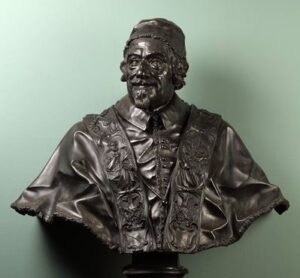
AR 1904, p.25 (describing the original as by “Bernini. S.K.Museum”; price: £1/10/-)
[photo: V&A bronze (no.1089-1853)]
This cast evidently reproduced the bronze bust of c.1690 in the V&A Museum, ascribed to Domenico Guidi (1625-1701). Alexander VIII was Pope from 1689-91.
II.4 Antique Head {presented by the Education Department, Melbourne, by 1894}
NGV 1894, VIII.76
The details listed in the 1894 NGV catalogue offer little scope for identification.
II.5 Apollo Belvedere [bust] {probably presented by James Murphy, 1862}
AR 1870-71, p.28 (Schedule XXIX, II “casts of busts and masks,” probably this bust); NGV 1894, VIII.25; Cf.Brucciani (1870?), p.28 & Brucciani (1891), p.7 (bust)
The bust identified in NGV 1894 as after the Apollo Belvedere was presumably the Apollo bust listed in AR 1870-71 as presented to the Melbourne School of Design by Murphy. “Municipal Statuary” (1908) lists a “handsome classical bust” of Apollo as no longer required by the NGV, but it is unclear whether this refers to the present cast or II.6.
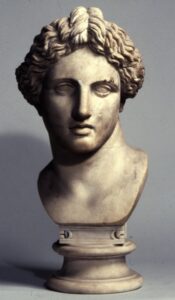
NGV 1865, bust no.3; AR 1870-71, p.42; not listed in NGV 1894
[photo: Townley bust, British Museum]
This cast is catalogued in NGV 1865 as a copy of the Townley head of Apollo in the British Museum (1805,0703.59), acquired from the Albani collection, Rome, in 1773 (as reproduced here). Charles Townley recorded Winckelmann’s description of the original as “a rare specimen of the sublime early style of Greek sculpture,” but it is now catalogued by the British Museum as a Roman copy, “considerably restored and reworked.” As mentioned above, an Apollo bust noted in “Municipal Statuary” (1908) as no longer required by the NGV may refer either to the present cast or to II.5.
II.7 Aristotle {by 1865}
NGV 1865, bust no.4; AR 1870-71, p.42; not listed in NGV 1894
The Greek philosopher (384-22 BC) studied with Plato, taught Alexander the Great, and then established his own school in Athens in 335 BC. His extant writings, covering a large range of topics, from aesthetics to natural science and political philosophy, were widely influential.
II.8 Augustus Caesar {presented by Master Jeffreys, 1863}
“Donations” (1863); NGV 1865, bust no.5; NGV 1894, VIII.35; cf.Brucciani (1870?), p.8, & Brucciani (1905), p.47 (“Young Augustus”)
After defeating Mark Antony at Actium in 37 BC, Augustus (63 BC – 14 AD) ruled as Rome’s first Emperor. Another bust (“Augustus, the young”) noted in the list of casts donated by James Murphy (AR 1870-71, p.28), may have been a duplicate; however, only one cast is listed in NGV 1894. The list of casts no longer required by the NGV in “Municipal Statuary” (1908) includes a bust of Augustus, presumably this copy.
II.9 Bacon {by 1865}
NGV 1865, p.30, bust no.6; AR 1870-71, p.42; NGV 1894, VII.6; cf.Brucciani (1858?), cat.120
This cast showed English statesman and philosopher Francis Bacon (1561-1626), noted particularly for formulating the principle of scientific induction.
II.10 Barnade {1904}
AR 1904, p.25 (“Head Barnade”; price: £0/9/6)
No “remarkable personage” of this name (or similar) seems to be listed in the standard biographical sources. Perhaps the entry in the 1904 annual report was a misprint.
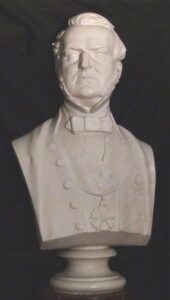
NGV 1894, VII.16
[comparative photo: Bust of Barry by Scurry, 1884 (Supreme Court of Victoria Library)]
The origin and exact date of acquisition of this image of the Melbourne Public Library founder (1813-80) are uncertain. James Scurry’s posthumous plaster bust of Barry, commissioned for the Supreme Court of Victoria (reproduced here), may have been the source. For other portraits of Barry, see linked entry.
II.12 Borgia, Lucrezia {1904}
AR 1904, p.25 (price: £0/12/6)
The daughter of Pope Alexander VI and the brother of Cesare Borgia, Lucrezia (1480-1519) acquired a notorious reputation (mostly posthumously?) as a femme fatale and poisoner. In 1502, she married Duke Alfonso de’Este of Ferrara (1476-1534), a noted patron of Titian and others. A portrait acquired for the NGV through the Felton Bequest in 1956 (as an anonymous early 16th-century “Portrait of a Youth”) was identified recently as a portrait of Lucrezia (1520s?) by the Ferrarese painter Dosso Dossi (c.1486-1541/2) and/or his brother Battista Dossi (active 1517-48): for details and a reproduction, see https://www.theguardian.com/artanddesign/2008/nov/25/portrait-lucrezia-borgia-australia and https://www.ngv.vic.gov.au/explore/collection/work/3746/ (both accessed 6 Oct.2020).
II.13 Bright {1872}
AR 1872, p.23 (as bought from Brucciani); NGV 1894, VII.11
John Bright (1811-89) was an English reform politician who opposed the Corn Laws and supported free trade, together with Cobden (see II.29), denounced the Crimean War (1854), and was involved with the Reform Act of 1867. Melbourne’s cast was listed in AR 1908 as lent to the Exhibition Trustees.
II.14 Lord Brougham {by 1865}
SB p.74; NGV 1865, bust no.8; AR 1870-71, p.42; NGV 1894, VII.23; cf.Brucciani (1858?), cat.102
As British Lord Chancellor, Henry Brougham (1778-1868) played a key role in ensuring that the 1832 Reform Act and the 1833 Slavery Abolition Act passed through the House of Lords. A note added to the NGV stock-book entry for this bust indicates “shattered 4/5/04.”
II.15 Brunel {by 1865}
NGV 1865, bust no.9; AR 1870-71, p.42 (quoted below); NGV 1894, VII.49; AR 1900, p.31, noting the loan of this cast to the Working Men’s College, Melbourne (now RMIT University)
This bust showed Sir Marc Isambard Brunel (1769-1849), as the 1865 NGV catalogue explains, adding a thumbnail sketch of the French-born sitter: “Engineer; invented block-making machinery in Portsmouth Dockyard; designed and executed the Thames Tunnel, and many other works of great ingenuity and usefulness.” His son, Isambard Kingdom Brunel (1806-59), joined his father’s office, and became even more famous for his engineering feats, especially bridges and tunnels for Britain’s expanding rail network.
II.16 Buffon {by 1865}
NGV 1865, bust no.10; AR 1870-71, p.42; NGV 1894, VII.40; AR 1900, p.31, noting the loan of this cast to the Working Men’s College, Melbourne (now RMIT University)
George-Louis Leclerc (1707-88), dubbed Comte de Buffon by Louis XV, is famed for his Histoire naturelle, published in 44 volumes between 1749 and 1767. There is a bust by Houdon.
II.17 Edmund Burke {by 1865}
NGV 1865, p.30, bust no.11; AR 1870-71, p.42; NGV 1894, VII.8
Irish political philosopher and Whig parliamentarian (1729-97).
II.18 Robert O’Hara Burke {by 1870}
AR 1870-71, p.28 (under Busts and Casts of Busts); not listed in NGV 1894
This bust of the ill-fated Australian explorer (1821-61), apparently in plaster, is recorded in the consolidated Annual Report for 1870-71 (covering 1853-70) as “presented by a committee of gentlemen”; the exact date of presentation is unclear. Its relationship to Charles Summers’ Burke and Wills monument, installed in Melbourne in 1865, is also uncertain.
II.19 Burns {by 1865}
NGV 1865, bust no.12; AR 1870-71, p.42; not catalogued in NGV 1894
This bust of Robert Burns (1759-96) is catalogued in the 1865 NGV catalogue, but not in the 1894 edition. However, this can hardly be attributed to waning local interest in the famed Scottish poet. On the contrary, Burns had an enthusiastic following amongst Melbourne’s Scottish community, who financed a memorial statue, produced by Scottish sculptor George Anderson Lawson (1832-1904), and unveiled in St Kilda Road in January 1904; the statue is now in the Treasury Gardens: see e.g. https://melbourneartcritic.wordpress.com/tag/memorial-statues/ (accessed 15 August 2020).
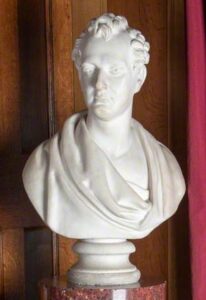
NGV 1865, bust no.13; AR 1870-71, p.42; NGV 1894, VII.69; cf. Brucciani (1858?), cat.105
[photo: Baily’s marble bust of Byron at Newstead Abbey]
Byron’s poetry and dramatic life both exemplify the Romantic era. Baily (see cast I.50) carved his bust of the poet (1788-1824) in about 1826; several marble versions and plaster casts are extant, one reproduced here.
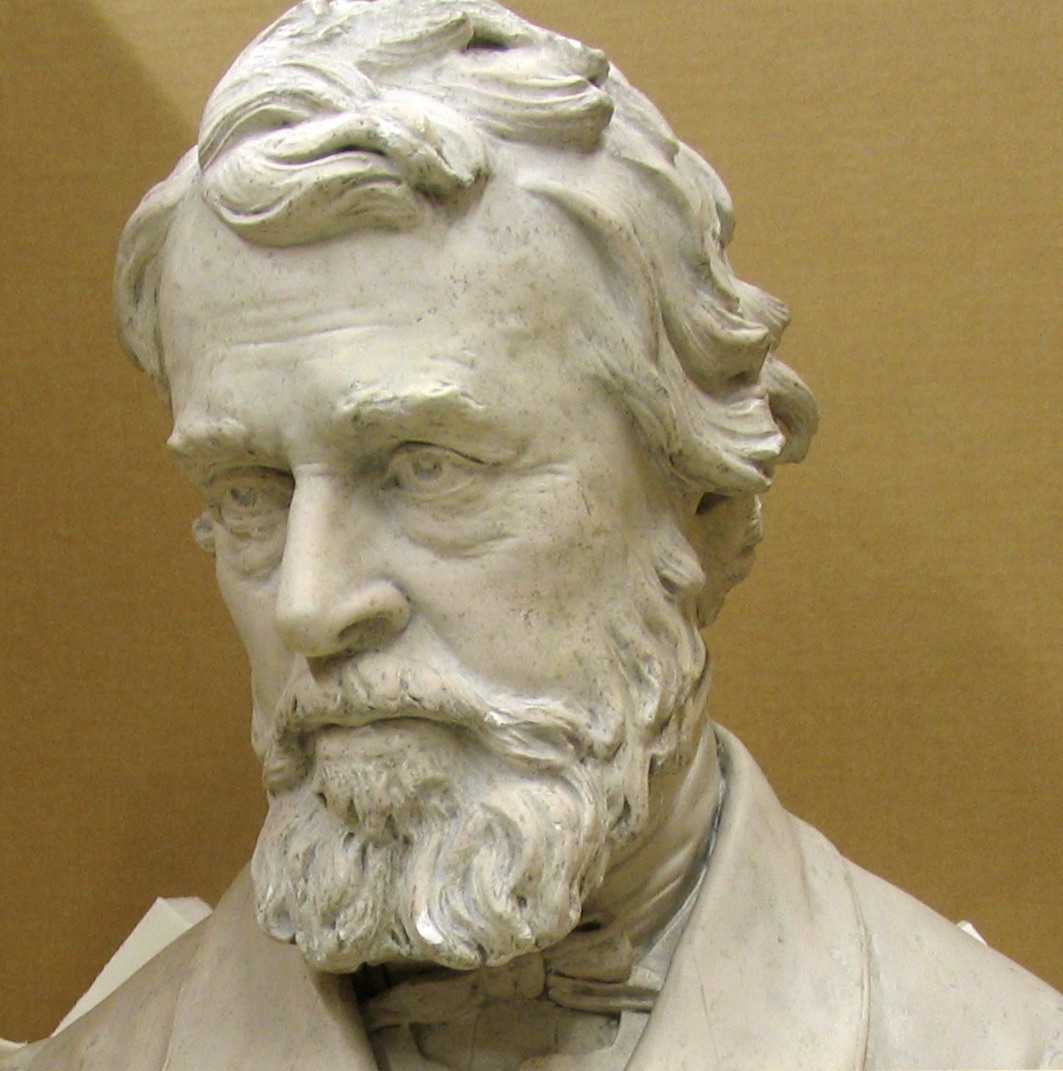
AR 1872, p.23 (as purchased from D.Brucciani); NGV 1894, VII.55
Thomas Carlyle (1795-1881) was a Scottish essayist and historian, whose major writings include Sartor Resartus (1833-34) and histories of the French Revolution (1837) and Frederick the Great (1858-65).
For this bust, see SLV catalogue (YPCLTS 51; listed as by D.Brucciani), and Galbally, First Collections (1992), cat.74, both noting it as 70 cm high. It is currently in storage, but an ID photo supplied by the SLV (detail reproduced here) indicates a similarity to other busts of Carlyle produced before his death: see e.g. a marble bust in Dundee by William Brodie 1879 (https://www.artuk.org/discover/artworks/thomas-carlyle-255038).
II.22 Chantrey {1872}
AR 1872, p.23 (as bought from D.Brucciani); NGV 1894, VII.77
English sculptor Sir Francis Chantrey (1781-1841) produced portrait statues and busts of a generally idealizing character, including several reproduced in other casts formerly in Melbourne: see II.62 (Hunter) and II.131 (Watt). He also taught John Francis: see now Francis Lord Melbourne 1837 {1901} SLV [SC].
II.23 Charles I {by 1865}
NGV 1865, bust no.15; AR 1870-71, p.42; NGV 1894, VII.105; cf.Brucciani (1870?), p.18 (3’ high)
Charles (1600-1649), crowned in 1625, and his French wife Henrietta Maria, presided over a sophisticated English court, exemplified by van Dyck’s role as court painter from 1632. But his perceived Catholic sympathies and autocratic style riled Parliament, leading to the English Civil War (1642-45), and his subsequent imprisonment and beheading. See also II.33 (Cromwell).
Melbourne’s cast was listed in AR 1908 as lent to the Exhibition Trustees, and also noted in the Age, May 1908 (see “Municipal Statuary”), as “with much hirsute adornment.” This may suggest that the cast reproduced a copy of Gianlorenzo Bernini’s widely-copied marble bust of Charles I (1635-40; formerly Whitehall Palace, destroyed by fire in 1698). Bernini’s famous bust was made not from life but from van Dyck’s “Triple Portrait” of the monarch (1635-36; British Royal Collection).
II.24 Lord Chatham {c.1860}
Summers list 1861, no.19; NGV 1865, bust no.16; AR 1870-71, p.42; NGV 1894, VII.25
William Pitt the Elder (1708-1778), known for his grand oratory and aggressive foreign policy (particularly against France), was made 1st Earl of Chatham in 1766, and was British Prime Minister from 1766-78. William Pitt the Younger (see cast II.104) was his second son.
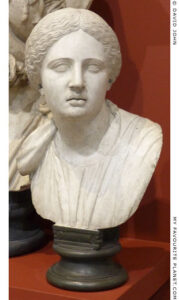
NGV 1880, p.35; NGV 1894, VIII.66; cf.Brucciani (1858?), cat.83/4 (?), and later Brucciani catalogues, e.g. 1891, pp.8-9
[photo: plaster cast based on the bust of one of the daughters of Niobe, from the collection of Anton Mengs (Dresden, Semperbau)]
The Niobe group, discovered in Rome in 1583 and now in the Uffizi, is an extraordinary ensemble of marble copies after Greek originals described by Pliny the Elder as by Scopas and Praxiteles: see Haskell & Penny 1981, cat.66 (with reproductions, also noting other related works in other collections). They illustrate the legend of Apollo and Artemis’s murderous response to the Theban queen Niobe’s boast about her many offspring, told in Homer’s Iliad and other sources. The Uffizi figures were prized particularly for the restrained suffering they expressed (evidently influential on Baroque artists such as Guido Reni), and the fame of the sculptures continued in the 18th and 19th centuries. Brucciani & co. sold casts of individual figures as well as masks, but it is impossible to be certain which statue served as the model for the present cast. The bust reproduced here is a plaster cast based on one of the daughters in the group, from the collection of Anton Raphael Mengs (1728-79): see http://www.my-favourite-planet.de/english/people/n1/niobe.html. There is an historic photograph of the Uffizi group, by Longworth Powers, in Powers (L.) & others Views of Florence {c.1888} SLV [PH].
II.26 Child’s Head. Original by Donatello {by 1894}
NGV 1894, VIII.89
In the absence of any specific details, this cast may be presumed to have been based on one of the many heads of children that have circulated since the 19th century, supposedly by Donatello or contemporaries such as Luca della Robbia or Desiderio da Settignano. In most cases, claims that they date back to the Renaissance seem tenuous. See also *Donatello [after] Boy’s Head {by 1894} Loc? [SC], a different work, possibly in bronze, though it was also listed among the other casts in NGV 1894 (VIII.71).
II.27 Cicero {by 1865}
NGV 1865, bust no.17; AR 1870-71, p.42
The Roman politician and orator (106-43 BC), famous for his speeches against corruption, was killed after condemning Mark Anthony in the aftermath of Julius Caesar’s own assassination.
Melbourne’s cast was listed both in AR 1908 (as lent to the Exhibition Trustees) and “Municipal Statuary” (1908), with the equivocal comment that it “might be mistaken for the cast of some executed criminal borrowed from Pentridge”! Later, as Ann Galbally notes (“Lost museum,” 1988, p.46), it was acquired by well-known Australian painter Pro Hart (1928-2006). An effort to track it down (not yet attempted) may also help identify its probable source; there are many extant busts supposedly of Cicero: see now https://commons.wikimedia.org/wiki/Category:Busts_of_Cicero (accessed 8 June 2023)
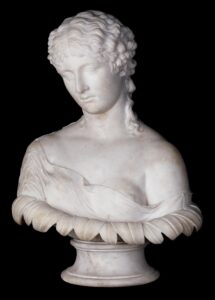
SB, p.12, and AR 1870-71, p.28 (casts presented by Murphy); NGV 1894, VIII.28 (noting both Murphy as the donor, and the Townley bust in the British Museum as the source)
[photo: Townley bust (BM 1805,0701.79)]
This cast, one of those presented by James Murphy in 1862 – see now Casts – III.Miscellaneous (i) – is identified in NGV 1894 as based on the popular British Museum bust from the Townley collection (regarded as Roman work, extensively reworked in the 18th century): see photo at right. The pre-Felton collection also included a separate bust based on the same figure, but in Parian porcelain (and described thus in a separate entry on p.28 of AR 1870-71), see now * Unknown (Copeland & Sons?) Clytie {by 1865} Loc? [SC].
In 1908, Melbourne’s plaster cast was listed in both the Age report on casts no longer required by the NGV (see “Municipal Statuary”) and in AR 1908 (as lent to the Exhibition Trustees).
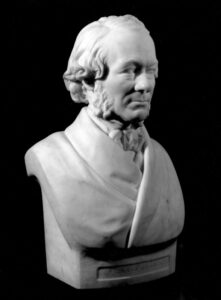
AR 1872, p.23 (as purchased from D.Brucciani); NGV 1894, VII.29
[photo: marble bust by Woolner, National Portrait Gallery, London]
Richard Cobden (1804-69), Yorkshire parliamentarian and cloth manufacturer, campaigned against the unpopular Corn Laws (abolished in 1846), and for free trade between England and France, enshrined in the Cobden-Chevalier Treaty (1860). The present cast may have been based on the marble bust of him by Thomas Woolner, 1866 (NPG 219): see photo at right.
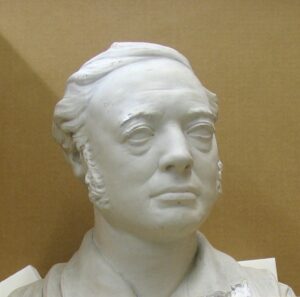
AR 1872, p.23 (as bought from D.Brucciani); NGV 1894, VII.74
Samuel Taylor Coleridge (1772-1834) joined Wordsworth (see II.133) in publishing Lyrical Ballads (1798), which opened with his famous Rime of the Ancient Mariner. Later, he continued to write poetry, as well as some fine literary criticism.
For this bust, see SLV catalogue (YPCLTS 78; listed as by D.Brucciani), and Galbally, First Collections (1992), cat.73, as 70 cm high. It is currently in storage, but an ID photo supplied by the SLV (detail reproduced here) suggests a similarity to other posthumous busts of Coleridge, e.g. one by William Thornycroft, 1884 (NT 253350; in the Coleridge Cottage, Somerset): see http://www.nationaltrustcollections.org.uk/object/253350.
II.31 Conde {1904}
AR 1904, p.25 (price: £0/12/6)
Identification is uncertain, since several famous Frenchmen have held this title. In the absence of further information, two possibilities seem equally likely:
either (i) Louis, the 4th Prince de Condé (1621-86),known as “the Great Condé,” one of Louis XIV’s generals, who defeated the Spanish in Franche-Comté (1668): for the history, see Simonneau after Le Brun Franche Comté reconquered 1688 {1879} NGV [PR]. An 1852 edition of Lord Mahon’s biography of him (written in 1842 and originally published in 1845) was an early acquisition for the Melbourne Public Library: see MPL 1857, II, p.9;
or (ii) the last Prince de Condé, Louis d’Orléans (1845-66), who died in Sydney, aged only 20, during a world trip arranged by his father, in exile in England after the 1848 Revolution: see now Ivan Barko, “Le petit Condé: the death in Sydney in 1866 of Australia’s first royal visitor,” Explorations: Journal of French-Australian Connections 35 (Dec.2003), pp.26-32 (cited in the Wikipedia article on Louis d’Orléans).
II.32 Cowper {by 1865}
NGV 1865, bust no.19; AR 1870-71, p.42; NGV 1894, VII.73
William Cowper, English poet (1731-1800), noted for his evangelical fervour, and his focus on nature (prefiguring Wordsworth: see II.133).
II.33 Oliver Cromwell {by 1870}
Not listed in NGV 1865; AR 1870-71, p.42; NGV 1894, VII.101; Cf.Brucciani (1870?), p.19, and other Brucciani catalogues
Cromwell (1599-1658) led the Puritan Revolution against Charles I (see II.23), and ruled as Lord Protector, 1653-58. After the Restoration of the British monarchy in 1660, his body was disinterred from Westminster Abbey and hanged from the gallows at Tyburn. See also * Unknown (British 17C) “Portrait, time of Cromwell” {1870} Loc? [PA], including further information, and a reproduction of a comparative portrait of Cromwell by Samuel Cooper.
II.34 Cruikshank {1872}
AR 1872, p.23 (as bought from D.Brucciani)
This bust showed the English illustrator George Cruikshank (1792-1878): the pre-Felton collection included several of his prints (refer linked entry for details).
II.35 Cuvier, Georges {by 1865}
NGV 1865, bust no.21; not listed in NGV 1894
French naturalist (1769-1832), noted for his studies of comparative anatomy and palaeontology.
II.36 Dawn (mask) [Michelangelo] {1904}
AR 1904, p.25 (price: £0/6/-); cf.Brucciani (1891), p.10 (no.2328: Dawn on Pedestal, by Michael Angelo [mask]; also priced at £0/6/-)
The price listed in AR 1904 correlates with the listing in Brucciani (1891). The source was obviously the famous Medici Chapel statue (see also I.39).
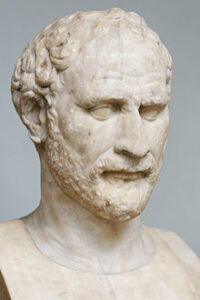
NGV 1865, bust no.22 (noting the source as the British Museum bust acquired in 1818); AR 1870-71, p.42; NGV 1894, VIII.21
[photo: British Museum bust]
The bust in London, reproduced here, is said to be a Roman copy of a 4th-century original by Polyeuktos. For the famed Athenian orator (384-322 BC), see also I.41 (a cast of a full-length statue in the Vatican, probably also based on the same Greek original). Melbourne’s cast was listed in both “Municipal Statuary” (1908) and in AR 1908, as lent to the Exhibition Trustees.
II.38 Diana (mask) {by 1894}
NGV 1894, VIII.54; cf.Brucciani 1891, p.10 (no.2417)
Brucciani sold masks based on the Louvre statue of Diana a la Biche (see I.43), and this cast was probably an example (though its exact origin is not spelt out in NGV 1894).
II.39 Diana (bust) {presented by James Murphy, Esq., 1862}
NGV 1865, bust no.23; AR 1870-71, p.28; NGV 1880, p.28; NGV 1894, VIII.29; cf. Brucciani (1891), p.7 (no.1617)
According to the 1870-71 Annual Report, this was a bust of the head of “Diana (robing)” (see I.44). It was presumably the bust of Diana listed in 1908 in both “Municipal Statuary” (as no longer required for the NGV collection) and AR 1908 (as lent to the Exhibition Trustees).
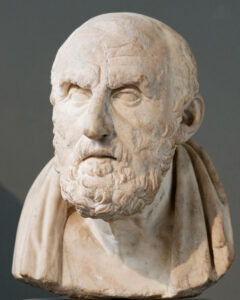
NGV 1865, bust no.24; AR 1870-71, p.42; NGV 1894, VIII.100
[comparative photo: bust of Chrysippos in the British Museum (bequeathed by Richard Payne Knight, 1824)]
Diogenes, known as the first “Cynic” philosopher (405-323 BC), scorned possessions. NGV 1865 and AR 1870-71 identify the original as a bust “bequeathed to the British Museum by the late R.Payne Knight, Esq…. in Pentelic marble.” Richard Payne Knight (1751-1824) left his large collection, mostly antique coins and medals, to the British Museum on his death, but the only statue from this bequest that seems relevant is a Roman/Hellenistic figure (BM 1824.0201.2), described by the Museum as of the Stoic philosopher Chriysippos, and clearly in the yellowish marble known as Pentelic: see comparative photo shown here.
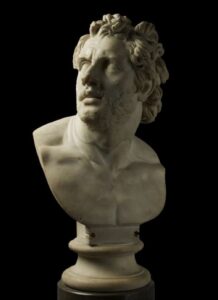
NGV 1865, p.33, bust no.42 (“Male head (one of the Homeric heroes?”); AR 1870-71, p.28 (“bust of Diomede”); NGV 1894, VIII.93 (Diomedes); cf.Brucciani (1858?), cat.85, & later eds.
[photo: Townley bust in the British Museum]
In Homer’s Iliad, Diomedes is one of the most heroic of the Greek warriors. Several extant Greco-Roman statues are identified as of him, and Brucciani (1858?) listed a cast. NGV 1865 indicates that the original was discovered by Gavin Hamilton at Hadrian’s Villa in 1771. These details clearly point to the Townley collection bust of a man described by the Museum as a companion of Ulysses (BM 1805,0703.86), dated to c.100-150 AD: see photo reproduced here. The BM catalogue quotes Townley’s own suggestions for the identification of the figure, including both “Head of a Homeric hero” and “Diomedes.”
II.42 Doryphorus (bust) {1892}
AR 1892, p.23 (“Plaster Bust”); NGV 1894, VIII.90
This cast was based on the marble statue in Naples (Mus.Arch.), recognized in 1863 as a Roman copy of the famous bronze by Polyclitus (c.450-440 BC), traditionally regarded as a demonstration of perfect human proportions.
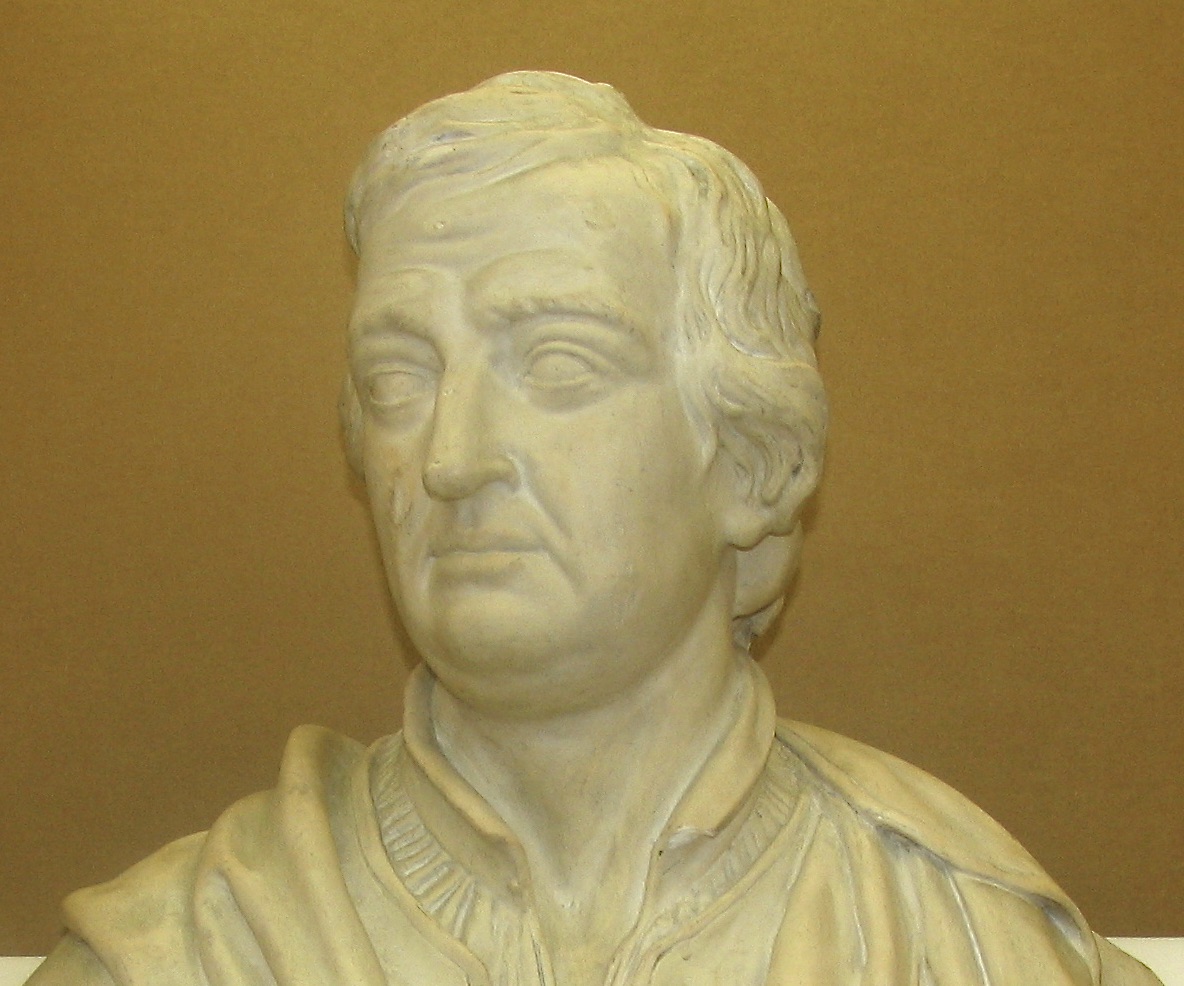
NGV 1865, bust no.25; AR 1870-71, p.42; NGV 1894, VII.62; cf.Brucciani (1858?), cat.108
John Dryden (1631-1700) flourished in the Restoration period, writing poetry and plays, as well as libretti for masques and operas by Henry Purcell. He also translated Virgil and other classical writers.
For this bust, see SLV catalogue (PCLTS 80) and Galbally et al., First Collections (1992), cat.72. It is currently in storage, but an ID photo provided by the SLV (detail shown here) suggests that its source may have been an original such as the marble bust of Dryden after French-English sculptor Louis François Roubiliac (1702-62), held in Canons Ashby, Northamptonshire (NT 494806): see http://www.nationaltrustcollections.org.uk/object/494806 (accessed 12 March 2021). For other casts based on Roubiliac, see also I.61 and II.56.
II.44 Lord Eldon {by 1865}
NGV 1865, bust no.26; AR 1870-71, p.42; NGV 1894, VII.18; cf.Brucciani (1858?), cat.103 (as Elton)
A lawyer and politician, John Scott, 1st Earl of Eldon (1751-1838), was British Lord Chancellor from 1801 to 1827.
II.45 Faraday {1872}
AR 1872, p.23 (as bought from D.Brucciani); NGV 1894, VII.32; AR 1900, p.31, noting the loan of this cast to the Working Men’s College, Melbourne (now RMIT University)
English scientist Michael Faraday (1791-1867) made numerous important discoveries relating to electricity, notably electromagnetic induction (1831).
II.46 Female Head {presented by Marshall Wood, Esq., c.1877-82}
NGV 1894, VIII.87
Unidentified cast, donated by Wood while he was working in Melbourne: see linked artist entry. See also II.80 (male head), presumably a pair for this cast.
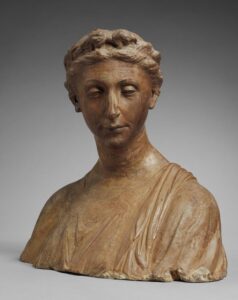
NGV 1880, p.32; NGV 1894, VIII.78
[photo: terracotta bust in the V&A (7585-1861)]
The source, identified in NGV 1894 as a terracotta work in the South Kensington Museum (later V&A), seems to have been the “female saint” reproduced here, formerly attributed to Donatello, now described by the museum as a “pasticcio,” combining a mid 19th-century head with what remained of a quattrocento bust. Melbourne’s cast is recognizable in the left foreground of the overview of the cast collection published in NGV 1905.
II.48 Female bust (Donatello) {1900}
AR 1900, p.29 (price given as £0/5/-)
The origins of this cast seem impossible to trace. For the 19th-century proliferation of heads and busts said to be by Donatello, see remarks above under II.26. See also previous entry.
II.49 Flaxman {by 1865}
NGV 1865, bust no.27; AR 1870-71, p.42
John Flaxman (1755-1826) was a noted British neoclassical artist, two of whose works were reproduced as casts in the Melbourne collection: see I.62 and I.82-83.
II.50 Charles James Fox {by 1865}
NGV 1865, bust no.28; AR 1870-71, p.42; NGV 1894, VII.19; cf.Brucciani (1858?), cat.121
A radical Whig politician, Fox (1749-1806) was leader of the opposition while William Pitt the Younger (II.104) was Tory Prime Minister. A vocal critic of King George III, Fox also supported both the American War of Independence and the French Revolution, and opposed slavery. There are several busts of him by Joseph Nollekens (1737-1823), one of which may have been the source for this cast.
II.51 Benjamin Franklin {by 1865}
NGV 1865, bust no.29; AR 1870-71, p.42; NGV 1894, VII.27; AR 1900, p.31, noting the loan of this cast to the Working Men’s College, Melbourne (now RMIT University)
Franklin (1706-90) was not only an American Founding Father, but also a political philosopher, polymath and inventor. There is a bust by Houdon (1778).
II.52 Gladstone {1872}
AR 1872, p.23 (purchased from D.Brucciani); 1880 catalogue; NGV 1894, VII.9
William Gladstone (1809-98) was English Chancellor of the Exchequer and then Prime Minister on several occasions from 1868 until shortly before his death.
II.53 Goethe {by 1865}
NGV 1865, bust no.30: AR 1870-71, p.42; NGV 1894, VII.60
Johann Wolfgang von Goethe (1749-1832), poet, dramatist and critic. His retelling of the legend of Faust (1808/1832) occupied him for much of the last part of his life.
II.54 Goldsmith {1872}
AR 1872, p.23; not listed in NGV 1894
Irish writer Oliver Goldsmith (1728-74), probably best known now for his play She Stoops to Conquer (first performed in 1773).
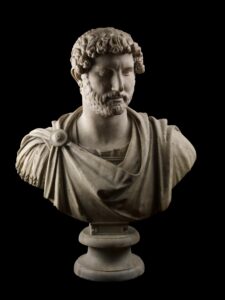
NGV 1865, bust no.32; AR 1870-71, p.43 (noting British Museum original); NGV 1894, VIII.12
[photo: Townley bust (BM 1805,0703.95)]
This cast reproduced the Townley bust of Hadrian, Roman Emperor from 117 to 138 (reproduced here): refer British Museum’s online catalogue. For the later history of Melbourne’s cast, see “Municipal Statuary” (1908) and AR 1908 (as lent to the Exhibition Trustees).
II.56 Handel {by 1865}
NGV 1865, bust no.31; AR 1870-71, p.42; NGV 1894, VII.81
Melbourne’s cast collection included both a statuette of the German-English composer, probably after a famous marble figure by Roubiliac, now in the V&A (for details, see I.61). The present cast may have been based on one of the same sculptor’s busts of Handel: see now David Wilson, “’By Heaven Inspired’: A marble bust of Handel by Roubiliac rediscovered,” British Art Journal 10.1, Spring/Summer 2009, pp.14-29 (available online), reproducing various examples.
II.57 Harvey {by 1865}
NGV 1865, bust no.33: AR 1870-71, p.43; NGV 1894, VIII.61
English physician William Harvey (1578-1657) discovered the circulation of blood in 1628, overturning traditional medical opinion.
II.58 Head Inconnue (Caffieri?) {1904}
AR 1904, p.26 (price: £0/12/-; details as shown above)
The Caffieri were a family of 17th-18th-century French sculptors, whose most famous member was Jacques (1678-1755). Little else can be determined about the source of this cast.
II.59 Heales {by 1870}
AR 1870-71, p.43
Richard Heales (1822-64), Victorian premier in 1860-1, was acknowledged in two busts in the early Melbourne collection: * Todt Richard Heales {by 1865} Loc? [SC], and this second cast, of unknown origin. Both busts were listed separately in AR 1870-71 (pp.43 and 28 respectively), but only Todt’s was catalogued in NGV 1894.
II.60 Herschel {1872}
AR 1872, p.23 (as bought from D.Brucciani); NGV 1894, VII.104; AR 1900, p.31, noting the loan of this cast to the Working Men’s College, Melbourne (now RMIT University)
This bust showed German-born British astronomer Sir William Herschel (1738-1822), who discovered Uranus in 1781, and was subsequently appointed Court Astronomer by George III. He was also a musician and a prolific composer. His sister Caroline also assisted his astronomical work, often making important individual discoveries of her own.
In the original edition of the present catalogue, the sitter was identified, incorrectly, as Sir William’s son Sir John Herschel (1792-1871); however, the correct identification is clarified in AR 1900, p.31, as noted above. Sir John continued his father’s astronomical work, and was listed among noted figures also deserving of plaster busts for the Melbourne collection in AR 1870-71, p.95. A number of Sir John’s astronomical publications were among the early acquisitions for the Melbourne Public Library (refer MPL 1857 and 1861 for details).
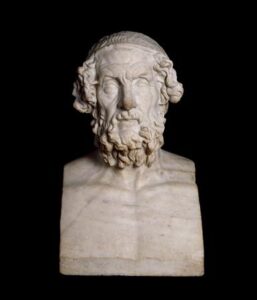
Summers list 1861, no.17; NGV 1865, bust no.35 (noting via original found 1780); AR 1870-71, p.43; NGV 1880, p.29; NGV 1894, VIII.69; cf.Brucciani (1891), p.8 listing two different busts), and (1905), p.41
[photo: Townley bust (BM 1805,1703.85)]
The details provided in NGV 1865 and AR 1870-71 identify the source as the Townley bust in the British Museum, a Roman copy after a Hellenistic type, reproduced here.
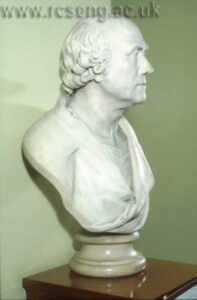
NGV 1865, bust no.36; AR 1870-71, p.43; NGV 1894, VII.39
[photo: original bust in London]
Hunter (1728-93) was a noted surgeon and anatomist. His posthumous bust by Francis Chantrey (for whom, see II.22), dated 1820, is in the collection of the Royal College of Surgeons in London: photo shown here. The head is said to be based on a portrait of Hunter by Reynolds.
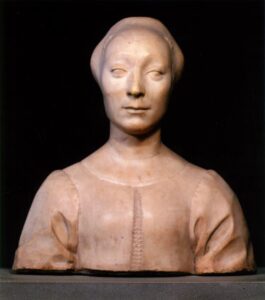
AR 1898, p.26: “Bust believed to be Isotta da Rimini. From original, Caposanto (sic}, Pisa”
[photo: Louvre bust formerly said to be of Isotta]
This bust was described in AR 1898 as representing Isotta degli Atti (1417-74), mistress and later wife of Sigismondo da Malatesta, the condottiero and ruler of Rimini from 1432-68 (a patron of both Leon Battista Alberti and Piero della Francesca). AR 1898 suggested that the source was a bust at the Camposanto, Pisa’s famous cemetery (built from the 13th century), but there is no record of such a work there; Isotta was actually buried in S.Francesco in Rimini (the “Tempio Malatestiano” designed for Sigismondo by Alberti). The most likely source for Melbourne’s cast would appear to be a marble bust in the Louvre (reproduced here), previously thought to be a portrait of Isotta from the studio of Florentine sculptor Desiderio da Settignano, but now seen as a bust of an unknown woman by Matteo Civitali, a sculptor from Lucca (1436-1501): see Arnold Coonin in Artibus et Historiae no.59, 2009, fig.14, p.53. The most faithful likenesses of Isotta degli Atti are presumably two profile medals of her by Matteo de’Pasti; an impression of the later medal (c.1453-4) is owned by the NGA, Canberra.
II.64 Dr Johnson {c.1860}
Summers list 1861, no.23 (“Head off”); NGV 1865, bust no.38; AR 1870-71, p.43; NGV 1894, VII.52; cf.Brucciani (1858?), cat.118
Samuel Johnson (1709-84) wrote the first significant English dictionary (published in 1755), and was a noted poet and critic, whose achievements are celebrated in James Boswell’s remarkable Life of Samuel Johnson (1791). There is a fine bust by Joseph Nollekens (1777), possibly the source of this cast.
II.65 Inigo Jones {by 1865}
NGV 1865, bust no.39; AR 1870-71, p.43; NGV 1894, VII.86; AR 1900, p.31, noting the loan of this cast to the Working Men’s College, Melbourne (now RMIT University)
The English architect and stage designer (1573-1652) admired Palladio (see II.98), and designed the Banqueting House at Whitehall (1619-22) and other buildings in classical style.
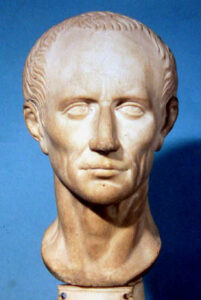
NGV 1865, bust no.14; AR 1870-71, p.42 (as Caesar); NGV 1880, p.27; NGV 1894, VIII.14; cf.Brucciani (1870?), p.28 & Brucciani (1905), p.47 (ill.)
[photo: British Museum bust (1818,011.3)]
Caesar (c.100–44 BC), having triumphed over Pompey and other rivals, became sole leader of Rome, but was assassinated shortly afterwards by staunch republicans (the subject of Shakespeare’s play). NGV 1865 identifies the cast as based on the British Museum bust reproduced here, now regarded as a forgery of c.1800, but accepted in the 19th century, and reproduced by Brucciani. Other busts are now seen as more likely images of Caesar, e.g. a head found in Turkey in 1868/9 (B.Mus.1870,0320,201). Melbourne’s cast was later listed as surplus to requirements: see “Municipal Statuary” (1908).
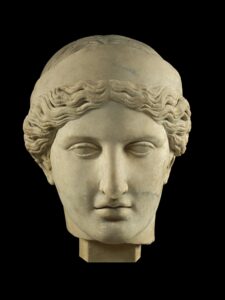
AR 1870-71, p.28? (‘mask’); NGV 1894, VIII.79; cf.Brucciani (1891), p.7 (no.2338, as noted below)
[British Museum bust (1873,0820.740)]
The cast catalogued in NGV 1894 may correspond to the one listed in AR 1870-71 as “Mask of Juno.” It may be the bust listed by Brucciani (1891) as “Juno, Castellani, British Museum,” noted as based on a head purchased from Alessandro Castellani in 1873, and now regarded by the museum as a Roman copy of a Greek original of Demeter or Hera/Juno: see photo reproduced here.
II.68 Keats {1872}
AR 1872, p.23 (as bought from D.Brucciani): NGV 1894, VII.75
John Keats (1795-1821) published a number of major English Romantic poems (e.g. The Eve of St Agnes and To Autumn), before dying of consumption in Rome, aged just 26.
II.69 “Head La Rienzi (?). Carpean” {1904}
AR 1904, p.25 (price: £0/3/4: information as quoted above)
These details seem particularly obscure, offering little hope for identifying the subject, authorship or source of this cast.
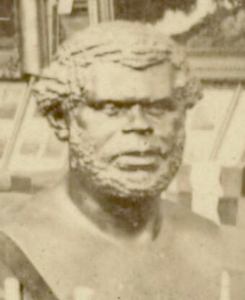
AR 1891, p.27
[comparative photo: bust of Lanne exhibited in Sydney, 1879]
This bust (called “Lanney”) was listed in AR 1891, under “Ethnographic Objects,” as one of three casts of Aboriginal Tasmanians donated by Melbourne art collector William Lynch. For the other two busts, of Truganini and Woureddy, see II.124 and II.134. Lanne (c.1835-69), the so-called last “full-blooded” Tasmanian aborigine, was taken to Flinders Island as a child in 1842 by Robinson (see II.108); after his death, his body was mutilated, in a disgraceful quasi-scientific attempt to discover the supposed physiological effects of his origins and “civilized” upbringing: see Stefan Petrow, “The Last Man: the mutilation of William Lanne in 1869 and its aftermath,” Aboriginal History vol.21 (1997), pp.90-112, available as http://press-files.anu.edu.au/downloads/press/p72631/pdf/article0615.pdf. The cast donated to Melbourne in 1891 is probably the one shown in the Tasmanian Courts of both the Sydney International Exhibition in 1879 and the Melbourne International Exhibition in 1880-81 (for details and further references, refer my forthcoming article in the La Trobe Journal 2021). Scurry’s authorship is suggested by mention of another plaster bust of Lanne, in the QV Museum and Art Gallery in Launceston, as his work (according to Scurry’s biography in DAAO).
II.71 Laocoon (bust) {presented by James Scurry, 1884}
SB, p.79; AR 1884, p.36; NGV 1894, VIII.52; cf.Brucciani (1870?), p.28 & Brucciani (1891), p.8 (busts)
Brucciani & Co. sold casts of Laocoon’s head, as well as the whole group (see I.74). A note in the NGV stock-book indicates that this bust was “broken by 2 students,” 2 Oct.1899.
II.72 Leopold II, King of the Belgians {presented by the Commissioners for Belgium, 1881}
NGV 1894, VII.107
One of the most thoroughly unpleasant rulers of any era, Leopold II (1835-1909), crowned King of Belgium in 1865, hardly merited recognition in the pre-Felton NGV – but in fact was represented not only by this cast (donated at the time of the 1881 Melbourne International Exhiibition), but also by a print: see now * Unknown after Ghémar Frères Léopold II & Marie-Henriette of Belgium {by 1894} Loc? [PR] (including further details regarding the maltreatment of the inhabitants of the Belgian Congo under Leopold’s rule). For the later history of Melbourne’s cast≤ see “Municipal Statuary” (1908) and the list of casts lent to the Exhibition Building in AR 1908.
II.73 Linnaeus {by 1865}
NGV 1865, bust no.40; not listed in NGV 1894
Swedish scientist Carl Linnaeus (1707-78) was the originator of modern taxonomy.
II.74 Locke {by 1865}
NGV 1865, bust no.41; NGV 1894, VII.21; cf.Brucciani (1858?), cat.112
John Locke, English empirical philosopher (1632-1704), is known particularly for his influential Essay concerning Human Understanding (1690). There are busts and portraits by Kneller and others.
II.75 Lyndhurst {1872}
AR 1872, p.23 (see above); not listed subsequently
One of several plaster busts listed in the 1872 Annual Report as purchased from Brucciani, this example was described as “broken beyond repair.” It presumably represented John Copley, 1st Baron Lyndhurst (1772-1863), Lord Chancellor of Great Britain under Peel in the 1830s and 40s.
II.76 Macaulay {1872}
NGV 1865, bust no.43; NGV 1894, VII.53
Thomas Babington Macaulay (1800-1859) was a Whig politician and writer; his History of England was begun in 1848.
II.77 Madonna [Mask] (Michelangelo) {by 1880}
NGV 1880, p.35; NGV 1894, VIII.83 or 84 (noting the South Kensington Museum as the source); cf.Brucciani (1891), p.10 (no.2204: Mask of an unidentified Madonna by Michelangelo)
This cast and II.78, evidently based on one or more of Michelangelo’s Madonnas, may have been acquired from Brucciani. The reference to the V&A is unclear, as nothing comparable seems to exist there now; perhaps these casts were made from other casts?
II.78 Madonna [Mask] (Michelangelo) {by 1894}
NGV 1894, VIII.83 or 84 (noting the South Kensington Museum as the source); cf.Brucciani (1891), p.10
Second cast, possibly based on the same original as II.77.
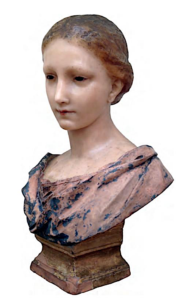
AR 1900, p.29 (details as quoted below; price given as £0/7/6)
[photo: original bust in Lille]
This cast was described in the NGV’s Annual Report for 1900 as “Bust of a Girl, from a wax bust, attributed to Raphael, in the Lille Museum,” pointing clearly to the source as the once-famous “Maiden of Lille,” bequeathed to the French museum in 1834, and reproduced here. The bust was widely copied in the later 19th and earlier 20th centuries, and given various romantic interpretations: see now Lawrence Riviale, “The ‘fortuna critica’ of the ‘Maiden of Lille’,” Burlington Magazine no.1406 (May 2020), pp.404-11. Riviale adds that a plausible 18th-century origin for the figure has been proposed recently (the Raphael attribution having long since been abandoned). Melbourne’s cast could have been made either from the original, or from a mould in Berlin.
II.80 Male Head {presented by Marshall Wood, Esq., c.1877-82}
NGV 1894, VIII.31
Without further information, it seems impossible to identify this cast or its source. For Wood, see linked entry; see also II.46.
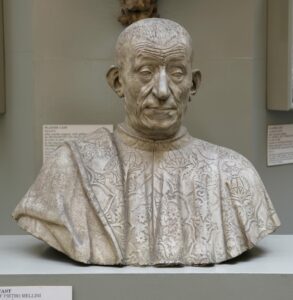
AR 1898, p.26 (noting that the original bust, by Benedetto da Maiano, is in the Bargello, Florence)
[photo: V&A cast, c.1885]
The original bust of Mellini, a Florentine merchant and patron, dates from 1474. For Benedetto da Maiano (1442-97), a member of a family of Florentine artists, see also II.120. There is a plaster cast of the present bust in the V&A (credited to Oronzio Lelli, c.1885): see comparative photo shown here.
II.82 Felix Mendelssohn-Bartholdy {by 1870}
AR 1870-71, p.28 (“presented by a Committee of Gentlemen”); NGV 1894, VII.90
The German composer (1809-47) visited England on several occasions, producing his oratorio Elijah in Birmingham in 1846.
II.83 Michelangelo {by 1865}
NGV 1865, bust no.2; AR 1870-71, p.42 (Angelo); NGV 1894, VIII.67; AR 1900, p.31, noting the loan of this cast to the Working Men’s College, Melbourne (now RMIT University); cf.Brucciani (1858?), cat.119
Michelangelo Buonarotti (1475-1564), described in Vasari’s influential Lives of the Artists (1st publ.1550) as bringing the development of Italian Renaissance art to a climax, was represented in the pre-Felton collection by several engravings after his works, as well as a number of plaster casts of his sculpture (for details, see linked entry). The most famous portrait of him is a bust by Daniele da Volterra, possibly the basis for this cast.
II.84 Milton {by 1865}
NGV 1865, bust no.44; AR 1870-71, p.43; NGV 1894, VII.71; Brucciani (1858?), cat.104
John Milton (1608-74) achieved early fame as a poet, but then spent his middle years in active support for the Puritan Revolution led by Cromwell (see VII.101). Later, after he had turned blind, he returned to poetry, publishing his most famous work, Paradise Lost, in 1667.
II.85 Moore {1872}
AR 1872, p.23 (as bought from D.Brucciani); NGV 1894, VII.63
Thomas Moore (1779-1852) was an Irish poet and musician, said to be to Ireland what Robert Burns is to Scotland. He was portrayed by Thomas Lawrence, and there are several busts.
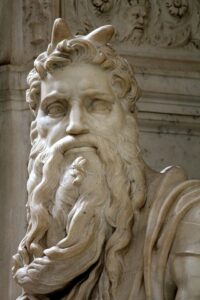
AR 1870-71, p.28
[photo: detail of Michelangelo’s Moses]
The “casts of busts and masks” donated by James Murphy in AR 1870-71 included this bust and also a mask (see II.87), both presumably derived from the famous statue of 1513-15 (S.Pietro in Vincoli, Rome), the embodiment of Michelangelesque terribilità: see detail reproduced here.
II.87 Moses (mask) {presented by James Murphy, 1862}
AR 1870-71, p.28; NGV 1880, p.35; NGV 1894, VIII.55; cf.Brucciani (1891), p.9 (no.461)
See previous entry.
II.88 Mulready {1872}
AR 1872, p.23 (as bought from D.Brucciani); NGV 1894, VII.87
Irish painter William Mulready (1786-1863); reproductions of his life drawings were donated to the pre-Felton collection by James Scurry in 1884.
II.89 Napoleon Bonaparte {by 1865}
NGV 1865, bust no.46; NGV 1894, VII.95
The pre-Felton collection also included other portraits of Napoleon (1769-1821): see Maile Napoleon I {1875} NGV [PR] and * Unknown artist Portrait of Napoleon I {1875} Loc? [DR]; as well as various images associated with the wars against him. He was frequently portrayed, usually in uniform.
II.90 Lord Nelson {by 1865}
NGV 1865, bust no.47; NGV 1894, VII.100; cf.Brucciani (1858?), cat.123
Horatio Nelson (1758-1805) died heroically during his triumph over French naval forces at the Battle of Trafalgar. See now * Sharpe after Maclise Death of Nelson {1878} Loc? [PR] and * Unknown after Carew The Death of Nelson {1871} Loc? [PR], the latter reproducing the famous relief at the base of the column erected in Nelson’s honour in Trafalgar Square (1830ff.).
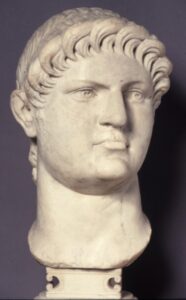
NGV 1865, bust no.48; AR 1870-71, p.43 (quoted below); NGV 1894, VIII.67; cf.Brucciani (1891), p.8 & (1905), p.47 (also noting B.Mus.original)
[photo: British Museum bust (1805,0703.236)]
AR 1870-71 notes that the original on which this cast was based was “brought from Athens by Dr Askew, 1740,” clearly identifying it as the Townley bust in the British Museum, now regarded as an 18th-century reworking of a Roman original: see photo. Nero’s reign as Roman Emperor (54-68 AD) was marked by extreme extravagance and cruelty, culminating in his suicide at the age of 31. His persecution of Christians was a favourite 19th-century topic: see now * Bourne after Doré The Christian Martyrs 1875 {1876} Loc? [PR] and Tegazzo after Siemiradzki Les Torches vivantes de Neron 1878 {1879} NGV [PR]. Melbourne’s cast was listed in the 1908 Age report on casts no longer required for the collection (“Municipal Statuary”).
II.92 Newton {by 1865}
NGV 1865, bust no.49; AR 1870-71, p.43; NGV 1894, VII.97; AR 1900, p.31, noting the loan of this cast to the Working Men’s College, Melbourne (now RMIT University)
Sir Isaac Newton (1642-1727) formulated the theory of gravitation and its effect on heavenly bodies, and then went on to develop his famous laws of motion in Principia Mathematica (1687).
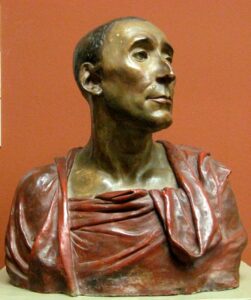
AR 1893 (report on the NGV Drawing School by F.McCubbin); NGV 1894, VIII.73 or 74
[photo: the original bust in the Bargello, Florence]
The original bust, in polychromed terracotta, was produced after the death of Uzzano (1359-1431), Gonfaloniere of Justice in Florence. The authorship of Donatello (noted in NGV 1894) is uncertain. There were 2 casts in Melbourne, both listed in NGV 1894 as donated by the Education Dept. (see also II.94), although only one is mentioned in AR 1893. One of them is visible in the overview of the casts published in NGV 1905.
II.94 Nicolo da Uzzano {presented by the Education Department, Melbourne, by 1894}
NGV 1894, VIII.73 or 74
The second of two casts, both listed in NGV 1894 as after Donatello and presented by the Education Dept.; see also previous entry.
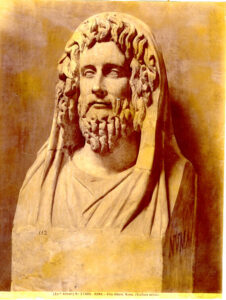
NGV 1894, VIII.39
[bust in Villa Albani, Rome]
Numa was the legendary second king of Rome from 715-653 BC, succeeding Romulus. A Sabine, he is said to have introduced many rituals and institutions later central to Roman culture, including the Vestal Virgins. This cast probably reproduced the bust in the Villa Albani, traditionally taken to represent him.
II.96 O’Connell {by 1880}
1880 catalogue, p.30; NGV 1894, VII.7
Daniel O’Connell (1775-1847), influential leader of the Roman Catholics in Ireland in the first half of the 19th century, was known as the “Irish Liberator.” In 1908, Melbourne’s cast was listed in both “Municipal Statuary” and AR 1908 (lent to the Exhibition Trustees).
II.97 Richard Owen {1872}
AR 1872, p.23 (“Professor Owen”; as bought from D.Brucciani); NGV 1894, VII.41; AR 1900, p.31, noting the loan of this cast to the Working Men’s College, Melbourne (now RMIT University)
English biologist and palaeontologist Owen (1804-92) invented the term “dinosaur” (“terrible reptile”) in 1841. Later, he argued that Darwin’s theory of evolution was simplistic in places, and was instrumental in the establishment of London’s Natural History Museum (1881).
II.98 Palladio {by 1865}
NGV 1865, bust no.50; AR 1870-71, p.43; NGV 1894, VII.78
Andrea Palladio (1508-80)’s classicizing villas and churches in Venice and its region strongly influenced later European architecture, especially in 18th-century England. In 1908, Melbourne’s cast was listed in both “Municipal Statuary” (1908) and AR 1908 (lent to the Exhibition Building).
II.99 Palmerston {1872}
AR 1872, p.23 (as bought from D.Brucciani); NGV 1894, VII.17
As British Foreign Secretary (from 1830) and Prime Minister (from 1855), Lord Palmerston (1784-1865) pursued a nationalist agenda that sometimes brought him into conflict with Queen Victoria (a clash embellished in the recent TV series Victoria, where Palmerston is portrayed as a scheming villain). Various portraits and statues were produced, including a Wedgwood bust, c.1870.
II.100 The Hon.H.Parkes {presented by Sir James Martin, 1869?}
PF 1869 (acc.no.p.78.10-1: probably this bust); NGV 1894, VII.34
Sir Henry Parkes (1815-96), known as the “Father of Australian Federation,” entered the New South Wales parliament in 1854, and became Premier in 1872 (and several times thereafter). The donor of this cast, Sir James Martin (1820-86), was also NSW Premier several times, including a 2-year period (1866-68) when he led a coalition government with Parkes. Involved increasingly actively in the federalist movement from the late 1880s, Parkes was the target of several biting Bulletin caricatures by Phil May (several 1888 examples were bought for the pre-Felton collection in 1903).
II.101 Sir Robert Peel {by 1865}
NGV 1865, bust no.51; AR 1870-71, p.43; NGV 1894, VII.24; cf.Brucciani (1858?), cat.99
Peel (1788-1850) was British Prime Minister during the 1830s and 40s; for further details, see * Linnell Sir Robert Peel 1838 {by 1894} Loc? [PR].
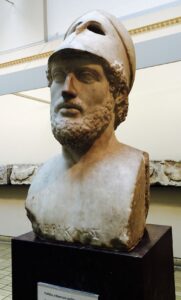
NGV 1865, bust no.52 (noting that the source was found near Tivoli in 1781); AR 1870-71, p.43; NGV 1894, VII.36; cf.Brucciani (1905), p.28 (noted as via the B.Mus.original; ill.)
[photo: Townley bust]
Pericles (c.495-429 BC) presided over the “golden age” of Athens, including the building and decoration of the Parthenon. The details in the NGV catalogues identify the source as the Townley bust acquired for the British Museum in 1805 (see photo at right), one of several Roman copies of a Greek original. Melbourne also owned a second cast: see next entry. See also AR 1908, for a later reference to at least one of these casts as lent to the Exhibition Building.
II.103 Head of Pericles {by 1894}
NGV 1894, VIII.57
This second bust of the famed Athenian leader (cf.previous entry) may have reproduced the same original, or another extant Roman copy (Berlin, Vatican etc.); both casts are listed in NGV 1894. See also previous entry, for a 1908 mention.
II.104 William Pitt {by 1865}
NGV 1865, bust no.53; AR 1870-71, p.43; NGV 1894, VII.30; cf.Brucciani (1858?), cat.122
Pitt (1759-1806) was British Prime Minister during the French Revolution and the rise of Napoleon (for further details, see * Goed after Owen William Pitt {by 1894} Loc? [PR]).
II.105 Plato {by 1865}
NGV 1865, bust no.54; AR 1870-71, p.43; NGV 1894, VIII.96; cf.Brucciani (1870?), p.29
Identification of the original is uncertain (there are various possibilities, and the NGV sources provide no details).
II.106 Raphael {by 1865}
NGV 1865, bust no.55; AR 1870-71, p.43; NGV 1894, VII.66; AR 1900, p.31, noting the loan of this cast to the Working Men’s College, Melbourne (now RMIT University); cf.Brucciani (1858?), cat.109
Raphael (1483-1520), born Raffaello Sanzio, was still seen by many in the 19th century as the greatest painter who ever lived. He was represented in the pre-Felton collection by a considerable number of engravings after his works, and a painting attributed to him (refer linked artist entry for details).
II.107 Reynolds {1872}
AR 1872, p.23 (as bought from D.Brucciani); NGV 1894, VII.88
Sir Joshua Reynolds (1723-92) was elected inaugural president of the British Royal Academy (1768). The pre-Felton NGV included several prints after his paintings (refer linked entry for details).
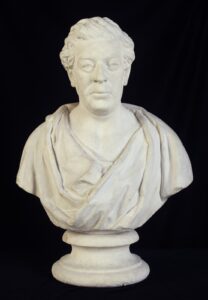
NGV 1865, bust no.56; AR 1870-71, p.43; NGV 1880, p.30; NGV 1894, VIII.62
[photo: SLV bust]
This appears to be the sole remaining cast of a plaster bust produced by Benjamin Law (1807-82) in 1836. The library’s catalogue indicates that it was donated in about 1870-71, but it already appears in the 1865 catalogue of Melbourne’s casts and statues. George Augustus Robinson (1791-1866), a builder by trade, and a devout Christian and amateur preacher, migrated to Hobart in 1824. In 1828, he was appointed by Lt-Governor George Arthur to attempt a “conciliation” between the Tasmanian Aborigines and the immigrants, which he effected eventually by simply arranging for the few Aborigines still remaining in southern Tasmania after the “Black War” (c.1824-31) to be relocated to Flinders Island. Modern assessments of these events vary, but Robert Hughes (The Fatal Shore 1987, p.121) plainly describes the treatment of the Tasmanian Aborigines as “the only true genocide in English colonial history.” Later, Robinson held the post of “Protector of Aboriginals” in Port Phillip (1839-49), then returning to England for the remainder of his life.
Gareth Knapman, publishing this bust in 2010 (see reference below), emphasizes the word “Pacificator,” inscribed on the back of the cast, in assessing Robinson’s role in both Tasmania and Victoria, thus complicating the traditional image of him as a humanitarian hero, developed by himself and others in the 1830s-40s. In Law’s bust, Robinson’s character is implied through the traditional Roman toga and idealized features, by contrast with the same artist’s busts of Truganini and Woureddy (see II.124 and II.134), produced at the same time (1835/36), and extant in multiple plaster casts. For other early images of Robinson, see Benjamin Duterrau’s The Conciliation (Tasmanian Museum and Art Gallery, 1840), and * Gauci (?) George Augustus Robinson {by 1865} Loc? [PR]. For further information, see Gareth Knapman, “The Pacificator: discovering the lost bust of George Augustus Robinson,” LaTrobe Journal 86, Dec.2010; and Gareth Knapman, “The Art of Conciliation,” Portrait 57, Winter 2017 (National Portrait Gallery, Canberra), both available online. See also the anonymous biography of Robinson in ADB, vol.2; and cast II.70 (William Lanne).
II.109 Lord John Russell {by 1865}
NGV 1865, p.35, bust no.57; AR 1870-71, p.43; NGV 1894, VII.10
English statesman (1792-1878), Prime Minister from 1846-52, and later 1st Earl Russell.
II.110 Bust of Franc Sadleier, D.D. {presented by William Corcoran, Esq., by 1870}
AR 1870-71, p.28 (as Sadler); NGV 1880, p.30 ; NGV 1894, VIII.60 (providing the details shown here)
Sadleier (1775-1851) was Provost of Trinity College, Dublin, from 1837 until his death.
II.111 Friedrich Schiller {by 1865}
NGV 1865, bust no.58; AR 1870-71, p.43; NGV 1894, VII.59
German poet and dramatist (1759-1805), friend of Goethe, and author of An die Freude (c.1788), later used by Beethoven as the basis for the final movement of his 9th Symphony.
II.112 Sir Walter Scott {by 1870}
AR 1870-71, p.43; NGV 1894, VII.56; Cf.Brucciani (1858?), cat.113
Scottish writer (1771-1832), noted particularly for his historical novels (Rob Roy, Ivanhoe, etc.). Substantial memorial statues to him were erected in both Edinburgh and Glasgow.
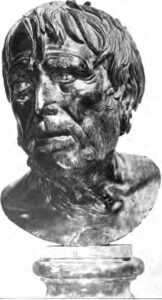
NGV 1865, bust no.60; AR 1870-71, p.43; NGV 1894, VIII.18; cf.Brucciani (1870?), p.29
[photo: bronze bust in Naples]
This was probably a cast of the “Pseudo-Seneca,” a bronze head found in Herculaneum in 1754 (Naples Mus.Arch.), previously understood to depict the Stoic philosopher: see photo. However, a marble bust inscribed with Seneca’s name, found in 1813 (now in Berlin), is now considered a more plausible likeness (for reproductions of both busts, see http://en.wikipedia.org/wiki/Pseudo-Seneca).
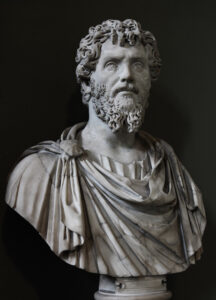
NGV 1865, bust no.61; AR 1870-71, p.43; NGV 1880, p.31; NGV 1894, VIII.33; cf.Brucciani (1891), p.9, & Brucciani (1905), p.47
[photo: British Museum bust (1805,0703.104)]
Roman Emperor Septimius Severus (145-211 AD). The Melbourne references are not specific as to the source, but it was probably the Townley bust in the British Museum, found in Rome in 1776, as reproduced here. The Melbourne cast was also recorded later, in “Municipal Statuary” (1908) and AR 1908 (lent to the Exhibition Trustees).
II.115 Shakespeare {c.1860}
Summers report 1861, no.21; NGV 1865, bust no.62; AR 1870-71, p.43; not listed in NGV 1894
This cast was obviously a separate cast from the larger copy of Scheemaker’s Westminster Abbey statue acquired in 1872 (see I.96), sold at auction in 1943.
II.116 Socrates {by 1865}
NGV 1865, bust no.63; AR 1870-71, p.43; not listed in NGV 1894
The philosophy of Socrates (c.469-399 BC) is known essentially through Plato (see II.105) and others influenced by his dialectic “method.” Traditionally said to be snub-nosed and ugly, he was represented thus in a number of busts (there are examples in the Louvre and elsewhere). Melbourne’s cast was listed in “Municipal Statuary” (1908) as one of those no longer required by the NGV.
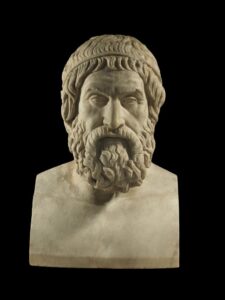
NGV 1865, bust no.64; AR 1870-71, p.43 (noting original as in the British Museum); NGV 1894, VIII.65; cf.Brucciani (1870?), p.29
[photo: Townley bust (1805,0703.87)]
The Townley collection bust in the British Museum (reproduced here) combines a Roman head, based on a Greek original, with a modern base. Melbourne’s cast was lent to the Exhibition Trustees later (AR 1908). See also I.98, a cast of the full-length statue of the playwright in the Vatican.
II.118 St George (bust) {1898}
SB, following p.546 (no.45): as bought for £1/5: see details above); AR 1898, p.26 (indentifying the source as Donatello’s statue in Florence); cf.Brucciani (1891), p.7 (no.2353)
[photo: Brucciani cast in the Royal Academy ©]
Donatello’s Orsanmichele statue of 1415-17 is now in the Florence Bargello. A plaster bust produced by Brucciani is extant in the Royal Academy in London: see photo reproduced here. However, Melbourne’s cast is noted specifically in the NGV stock-book as purchased from the local firm of Pellegrini & Co. in March 1898.
II.119 George Stephenson {by 1865}
NGV 1865, bust no.65; AR 1870-71, p.43; NGV 1894, VII.47; AR 1900, p.31, noting the loan of this cast to the Working Men’s College, Melbourne (now RMIT University)
The inventor of the railway engine (1781-1848). There are various portraits, including a bronze bust by E.W.Wyon (1811-85), held in the Science Museum, London.
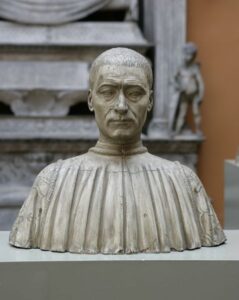
AR 1894, p.22 (as above); not listed in NGV 1894
[photo: plaster cast in the V&A]
Maiano (see II.81) produced his terracotta model of the wealthy Florentine merchant (1428-92), a rival of the Medici, in 1475 (Bode Museum, Berlin). It served as the basis for a marble bust later installed in the Strozzi Chapel, S.Maria Novella, Florence (now in the Louvre). Melbourne’s cast was listed in the 1894 Annual Report as donated by the Education Department. The cast reproduced here (apparently based on the Berlin bust) is in the V&A, dated to c.1864, and documented as made by a Signor Stiattesi.
II.121 Thackeray {1872}
AR 1872, p.23 (as bought from D.Brucciani); NGV 1894, VII.54
William Makepeace Thackeray (1811-63) is best known for his 1848 novel Vanity Fair, satirizing the new English middle classes. There are various portraits, including a statue by Sir Joseph Boehm.
II.122 Thomson, James {by 1865}
NGV 1865, bust no.66; AR 1870-71, p.43; not listed in NGV 1894
Scottish poet (1700-48), best known for his cycle The Seasons (1726-30).
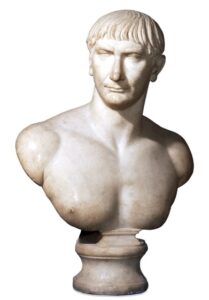
NGV 1865, bust no.67; AR 1870-71, p.43 (noting the source as the Townley bust in the British Museum); NGV 1894, VIII.16; cf.Brucciani (1870?), p.29 & Brucciani (1905), p.47
[photo: Townley bust. British Museum (1805,0703.93)]
The Roman Empire was at its greatest extent under Trajan’s rule (97-117 AD). For the triumphal Column erected in Rome in 113 AD to celebrate his victory over the Dacians, see Bartoli Colonna Traiana (1672) {by 1861} SLV [IB].
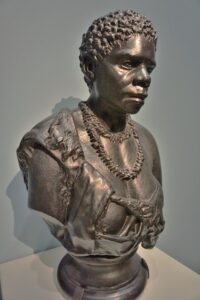
AR 1891, p.27
[comparative photo: cast in the National Portrait Gallery, Canberra: photo by Gordon Makryllos]
Gareth Knapman, discussing the National Portrait Gallery’s cast, observes that this bust of 1836 is imbued with a deep sorrow (“The Art of Conciliation,” Portrait 57, Winter 2017, National Portrait Gallery, Canberra, available online). This was one of the “casts of the last three survivors of the Tasmanian Race – Truganina, Lanney, and Woureddy,” donated by William Lynch in 1891, and described as “Ethnographic Objects”: for general comments, see II.70 (William Lanne).
The sculptor Benjamin Law (1807-82), who arrived in Hobart in February 1835, having worked as a silversmith in Sheffield, produced this bust and the busts of Woureddy (II.133) and the colonial “conciliator” G.A.Robinson (II.108) in 1835-6. The heads of the two native Tasmanians (who were coopted to help Robinson bring conflict to an end in the colony) proved particularly popular, and were cast in about 30 coloured plaster pairs, with extant examples held in the National Portrait Gallery, Canberra, and elsewhere, including a cast of the Truganini bust in the British Museum (2009.2025/1). In 2009, when a pair of Law’s busts of Truganini and Woureddy, described as “the first sculptures made and exhibited in British Australia,” were withdrawn from a planned auction at Sotheby’s in Melbourne, following significant protests: for a critical response, see David Hansen, “Seeing Truganini,” Australian Book Review, May 2010, pp.45-53. For the larger issues involved, see e.g. Bernard Smith, The Spectre of Truganini, Australian Broadcasting Commission, 1980 (Boyer Lectures)
II.125 Venus de Milo (bust) {presented by James Murphy, 1862}
AR 1870-71, p.28; NGV 1880, p.31; NGV 1894, VIII.82; cf.Brucciani (1891), p.7 (no.1616: bust)
For Melbourne’s cast of the Venus de Milo statue, see I.108.
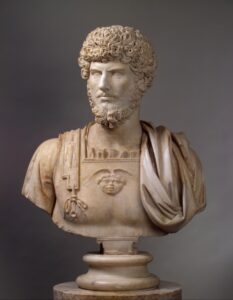
NGV 1865, bust no.68 (via an original “sold by Mr Lyde Brown to the Empress Catherine II of Russia”); AR 1870-71, p.43; NGV 1894, VIII.23; cf.Brucciani (1858?), cat.74 (quoted below) & Brucciani (1870?), p.29
[photo: Hermitage bust]
Lucius Verus, co-emperor with Marcus Aurelius, 161-69 AD, is characterized by Brucciani (1858?), as “licentious and dissolute” (listing a plaster bust of unidentified origin). The details recorded in NGV 1865 point to the source of Melbourne’s cast as the bust of Verus now in the Hermitage Museum: see photo reproduced here. Another “colossal” bust of Verus, in the Louvre, was presumably the basis for a cast formerly in Sydney, described as “heroic size” (see AGNSW catalogue 1888, p.93).
II.127 Queen Victoria {by 1865}
NGV 1865, bust no.69; AR 1870-71, p.43; NGV 1894, VII.14; cf.Brucciani (1858?), cat.1007
The cast of Prince Albert (see II.2) was presumably the pair of the present work, and both, as discussed in the remarks on that cast, may have been based on the marble busts of the royal couple by Joseph Durham (1855). However, this is only a speculative suggestion. This cast was presumably the one listed in “Municipal Statuary” (1908) and AR 1908 (lent to the Exhibition Trustees).
See also * Noble [after] Queen Victoria {c.1860} Loc? [SC], a Parian bust also listed in NGV 1894.
II.128 Bust of Publius Virgilius Maro [Virgil] {by 1865}
NGV 1865, bust no.71; AR 1870-71, p.43; NGV 1894, VIII.59; cf.Brucciani (1870?), p.29
The source of this cast of the author of The Aeneid (70-19 BC) is unclear. For the general difficulty of relying on any of the known images of him, see J.B.Trapp, “Virgil and the monuments,” Proceedings of the Virgil Society 18 (1986), available online. In 1908, Melbourne’s cast was listed as surplus to the NGV’s requirements – in “Municipal Statuary” – and also recorded as lent to the Exhibition Trustees (AR 1908).
II.129 Voltaire {c.1860}
Summers report 1861, no.22;NGV 1865, bust no.72; AR 1870-71, p.43; not listed in NGV 1894
French Enlightenment writer (1694-1778), best known for his Candide (1759); Houdon made several lively busts of him.
II.130 George Washington {by 1865}
NGV 1865, bust no.73; AR 1870-71, p.43; NGV 1894, VII.94
After leading the American forces in the War of Independence, Washington (1732-99) became the first US President in 1789. There are several busts and statues of him, the most faithful of which is generally regarded as Houdon’s terracotta bust (Mount Vernon, 1785). In 1840, Horatio Greenough made a remarkable marble statue of Washingon, modelled on the gigantic 5th-century BC statue of Zeus formerly in the Temple of Zeus at Olympia.
In 1908, Melbourne’s cast was noted as lent to the Exhibition Trustees (AR 1908), and also listed among casts no longer required by the NGV, in “Municipal Statuary” (1908), where it was described as wearing “that wild ragged-looking wig… that he wears on some of the United States stamps.” (perhaps suggesting that the Houdon bust was the source).
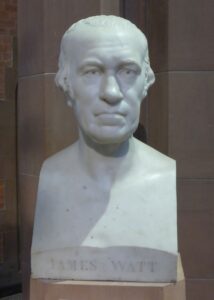
NGV 1865, bust no.74; NGV 1870-71, p.43; NGV 1894, VII.48; AR 1900, p.31, noting the loan of this cast to the Working Men’s College, Melbourne (now RMIT University)
[photo: marble bust by Chantrey]
Scottish engineer Watt (1736-1819) perfected the steam engine, facilitating the development of the Industrial Revolution and the railways (cf. II.119). Chantrey produced a marble statue of Watt, and a bust (Scottish Nat.Gall.), reproduced here. See also Pratt James Watt’s Workshop 1886 {1889} NGV [PA]. For Chantrey, see II.22.
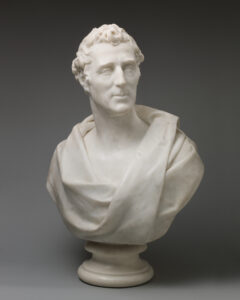
Summers report 1861, no.18; NGV 1865, bust no.75; AR 1870-71, p.43; NGV 1894, VII.102; cf.Brucciani (1858?), cat.98
[comparative photo: marble bust by Chantrey, 1823 (Met.Mus., NY)]
Arthur Wellesley, 1st Duke of Wellington (1769-1852), together with Marshall Blücher, won the decisive victory over Napoleon at the Battle of Waterloo in June 1815. His resultant fame led to many honours and portraits, both before and after his death and spectacular state funeral in November 1852. Melbourne’s cast was presumably based on an early source like the suitably heroic marble bust of 1823 by Chantrey (for whom, see II.22): see photo. Wellington was celebrated in several other pre-Felton prints and paintings: see e.g. Unknown after Dawe Duke of Wellington 1842 {1875} NGV [PR].
II.133 Wordsworth {1872}
AR 1872, p.23 (as bought from D.Brucciani); NGV 1894, VII.70
The poet William Wordsworth (1770-1850), who lived for much of his life in the English Lake District. Initially a harbinger of Romanticism, with Coleridge (see cast II.30), he later wrote reflectively about man and nature.
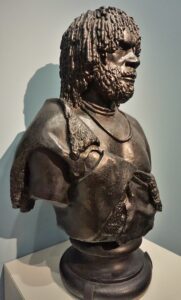
AR 1891, p.27
[comparative photo: cast in the National Portrait Gallery, Canberra: photo by Gordon Makryllos]
One of three busts of Tasmanian aborigines donated by William Lynch in 1891: see also II.70 (Lanne) and II.124 (Truganini); and, for further context, II.108 (bust of G.A.Robinson). This bust of Woureddy was said to be the most popular of the three busts by Benjamin Law, perhaps because of its “noble savage” characterization.
II.135 Sir Christopher Wren {by 1865}
NGV 1865, bust no.76; AR 1870-71, p.43; NGV 1894, VII.79; AR 1900, p.31, noting the loan of this cast to the Working Men’s College, Melbourne (now RMIT University); cf.Brucciani (1858?), cat.115
Wren (1632-1723) designed St Paul’s Cathedral (1675-1710), and numerous smaller London churches, following the Great Fire of London in 1666.
II.136 Sir John Young {by 1870}
PF 1869 (acc.no.p.78.9-1): presumably this bust); AR 1870-71, p.28; NGV 1894, VII.31
Young (1807-76), NSW Governor 1861-67, was also represented in Melbourne’s Oval Portrait series (no.34).
II.137 Bust of a Young Lady (Donatello?) {1898}
AR 1898, p.26 (“from original in wood, by Donatello”)
The source is unclear; see also comments on casts II.47 & 48 (with comments on the difficulty of identifying works like this).
II.138 Xenophon {by 1865}
NGV 1865, bust no.77; AR 1870-71, p.43; not listed in NGV 1894
Ancient Greek historian (c.435-354 BC).

